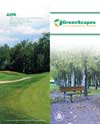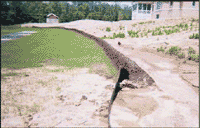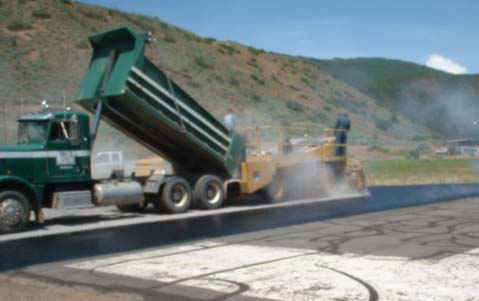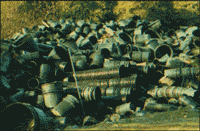GreenScapes: Environmentally Beneficial Landscaping
Highlights
View and print this brochure (8 pp, 757K, about PDF)
Brochure
EPA530-K-05-003
May 2005
What Is Green Scapes?
Roads and highways, golf courses and ski resorts, commercial buildings and industrial sites—the widespread use of economically and environmentally costly landscaping is everywhere. By simply hanging these landscapes to “GreenScapes,” you can save money and prevent pollution.
The US Environmental Protection Agency’s (EPA’s) GreenScapes program provides cost-efficient and environmentally friendly solutions for large-scale landscaping. Designed to help preserve natural resources and prevent waste and pollution, GreenScapes encourages companies, government agencies, and other entities to make more holistic decisions regarding their practices and purchases and their associated impacts on land, water, air, and energy use. By focusing on the “4 Rs”—reduce, reuse, recycle, and rebuy—you can help improve both your bottom line and the environment.
Why Is GreenScaping Important?

Brochure Cover
Think about some of the large-scale land uses in the United States—shopping and retail centers; recreational facilities such as golf courses, ski resorts, amusement parks, public gardens; roads and highways; abandoned industrial sites such as brownfields; college and university campuses; and military installations. Think about the millions of tons of materials that are hauled away, buried, or burned each day from landscaping and groundskeeping operations—trees, shrubs, brush, lumber, asphalt, and concrete, just to name a few. Also, consider the millions of gallons of water, pesticides, fuels, and oils used each and every day in landscaping. The costs of these materials—both economic and environmental—can be easily reduced or eliminated with updated landscaping methods.
What Can You Do?
Understanding the economic and environmental benefits of saving resources and preventing waste and pollution is key to bringing positive changes to your operations and surroundings. These changes can be made gradually. Set a combination of short- and long-term goals—activities that can be performed in a few weeks paired with actions that can be implemented later for future gains. Even small improvements can create a huge ripple-effect not only on your site, but throughout your industry and the environment. Focus on the 4 Rs:
Reduce
Reducing the production of waste is the first and most important step towards efficient materials use. When planning a new landscape design or updating a current one, avoid products that require frequent replacement or regular maintenance to reduce future waste. Durable products will long outlast those of lesser quality, reducing future waste generation and the need to purchase new or replacement products. Try some of the following waste reduction suggestions:

This filter berm made from compost demonstrates how well the organic material helps retain runoff in comparison to a typical silt fence in the lower portion of the photo.
- Reduce or eliminate plastic silt fencing and substitute with blankets, berms, and filtersocks made of compost, for erosion control and reduction of nonpoint source pollution. Compost provides superior filtration and erosion prevention/control, is more easily installed and maintained, and does not require energy-intensive removal or disposal from the site once the job is completed.
- Reduce nonpermeable hardscape wherever possible to minimize rainwater runoff and erosion. Consider parking areas or paths made from mulch or gravel. Where hard surfaces are necessary, use asphalt containing recycled tires—the surface will last longer and require less maintenance.
- Switch from benches, boardwalks, and signs made from wood to long-lived plastic lumber. Structures made from recovered plastic material do not require routine upkeep—saving paint, solvent, and labor costs. Plastic lumber also lasts many years longer than wood—greatly reducing maintenance and replacement costs.
- Conserve water through “Xeriscaping.” Plant vegetation that is not only drought resistant, but indigenous to a region’s soil and climate conditions. Once established, these native plants can survive with little care or water. Add compost to the soil to help improve water absorption and retention and further reduce water requirements. Native plants are also more pestresistant and healthier, thus requiring less fertilizers and pesticides. Long-lived, hardier vegetation can save money by lowering labor costs and money spent on maintenance supplies.
- Produce less green waste by limiting fertilizer and water use—this will save you money and maintenance time due to slower plant growth. Less landscape maintenance translates to fewer hours of equipment operations, saving fuel, maintenance, labor, and emissions and increasing equipment longevity.
- All pesticides are toxic to some degree—spot treat whenever possible. In most cases, treating an entire region with pesticides isn’t necessary if the problem is confined to specific areas. Treating more than necessary is wasteful and can be environmentally damaging. When treatment is necessary, consider using organic or biobased fertilizers and pesticides.
- Start or increase onsite composting of clippings, trimmings, leaves, and food scraps. Compost contributes vital nutrients and disease-suppressing properties to the soil, reducing the need for chemical fertilizers or pesticides. Compost is also an excellent soil amendment for seeding grass and young plants, reclaiming nutrient-poor soil, and preventing erosion.
- Top-dress your turf with compost—this can decrease fertilizer use by up to 50 percent and decrease irrigation needs by increasing water absorption and retention.
- For every one percent of organic matter, the soil can hold 16,000 gallons of plant-available water per acre of soil down to one foot deep.
- Place mulch over a plant’s root zone to reduce moisture evaporation and conserve water. Mulch also inhibits weed growth. Save money and make your own mulch by chipping wood wastes generated from your site.
- Use vegetation outside to reduce indoor heating and cooling needs. Deciduous trees planted appropriately along the south sides of buildings can reduce air conditioning costs by up to 20 percent; in winter they allow the sun’s rays to warm buildings. Coniferous trees planted to block prevailing northwest winter winds can reduce heating costs. Trees planted to shade paved areas reduce the summer “heat-island” effect that makes parking lots so inhospitable.
- Set mower blades higher. Longer top growth means deeper roots, making the grass more durable in drought conditions and better able to fight weeds and diseases without pesticides.
- Grasscycle—leave grass clippings in place (don’t bag) when mowing. The clippings quickly decompose and release valuable nutrients into the soil, reducing the need for fertilizers by 15 to 25 percent. This activity also reduces water use, grass disposal, and maintenance costs. Grass trimmings do not cause thatch.

Compost – An On-Par Alternative. The soil on the North Shore Country Club (Glenview, Illinois) golf course had elevated sodium levels—too high to maintain quality turf. Standard procedure called for the installation of a well to solve this problem, but that solution came with a quarter million dollar price tag. With a little research, North Shore found compost to be the economical alternative to enhance the quality of its soil.
Reuse
Reuse serves as another key component to environmentally beneficial landscaping. Many items can be reused effectively without adding much time or energy. Try some of the following reuse tips:
- Chip woody shrubs and tree clippings into mulch that can be applied to the landscape. This activity saves money on disposal costs while adding the benefits of mulch, such as moisture retention, weed prevention, and erosion control.
- Return wooden pallets to your supplier whenever possible. Nonreturnable pallets can be chipped and used on site for mulch or compost.
- Donate healthy plants to community gardens, schools, churches, or other local nonprofit organizations when reconfiguring or removing trees and shrubs from your landscape.
- Use alternative sources of irrigation water such as gray water, reclaimed water, and collected rain water. These options save water and money while helping to reduce runoff, erosion, and nonpoint source pollution.
Recycle

A “Growing” Plastics Recycling Business. Agri-Plas, Inc., an agricultural plastic recycler in Oregon, processes tons of discarded plastics from the agricultural and nursery industries each year. The company collects trays, pots, and greenhouse films from about 100 nearby nurseries and picks up baling twine and plastic agricultural chemical containers from local farmers and growers. Agri-Plas provides the recovered plastic to end users that make new products for the nursery and automotive industries.
Creating products from recycled materials saves energy and resources, and can often generate revenue. Try some of the following recycling suggestions:
- Send clippings, trimmings, and leaves that cannot be composted on site to a local composting facility in exchange for finished compost at a discounted price or fee.
- Save bedding trays and plant containers from annuals and other greenery and send them to a recycler for processing.
- Place recycling receptacles next to trash receptacles.
- Collect and recycle the used oil and tires from your vehicles and equipment.
Rebuy
Rebuying means re-thinking your purchasing habits. Look for products that meet your needs but have a better environmental profile than your current product purchases. Consider biobased, recycled content, and other environmentally preferable aspects in your purchasing decisions. Recycled products, for example, are often more durable than those made with virgin materials, saving money and raw materials over time. Rebuying is key to sustaining recycling markets, and it aids in the development of technology that conserves resources and prevents waste. You can work with your managers, clients, suppliers, and vendors to identify and establish specifications to purchase various environmentally preferable products. Try these rebuy tips:
- Use blankets and berms made of compost to minimize or eliminate soil erosion, runoff, and nonpoint source pollution. Compost is both a biobased product and a recycled product because it is made from recycled organic waste materials. Compost also makes an excellent air filter media for volatile organic compounds (VOCs).
- Select plastic lumber made from recycled bottles and bags for benches, signs, and other outdoor structures. Plastic lumber is an extremely durable material that lasts longer and requires less maintenance than traditional wood, realizing significant cost savings for you over the life of the material. The National Park Service currently has more than a dozen projects planned with plastic lumber.
- Use high efficiency lighting for roadways, parking lots, security, and landscaping.

This walking path at the Earvin “Magic” Johnson Recreation Area in Los Angeles County is made from rubberized asphalt, which is more resilient than traditional asphalt.
- Purchase biodiesel and biobased lubricants for your equipment. Besides being better for the environment, keeping less hazardous materials on your site reduces management costs and possibly insurance costs.
- If you have to have irrigation or ornamental water features, make sure to use the most water efficient equipment available.
- Use recycled glass for golf course bunker sand, beach sand, or filter media.
- Incorporate rubberized asphalt (made from recycled tires) for walking, running, bike, or cart paths—it extends the life of trails and reduces the frequency of repairs.
- Rethink your pesticide use through Integrated Pest Management (IPM). IPM reduces the risk from pesticides, and in some cases, reduces the amount of pesticides needed. IPM is based on a combination of techniques such as biological control, habitat manipulation, and modification of cultural practices, often including steps you can take before you ever encounter a pest problem. If pesticides become necessary, they are selected and applied in ways that minimize risks to human health and the environment and remove only the target organism.
Disclaimer
Reference to any specific commercial products, processes, companies, or services by trade name, trademark, manufacturer or otherwise, does not constitute or imply endorsement or recommendation by the US Environmental Protection Agency.
PDF Version (8 pp, 757K, about PDF)
![[logo] US EPA](../gif/logo_epaseal.gif)